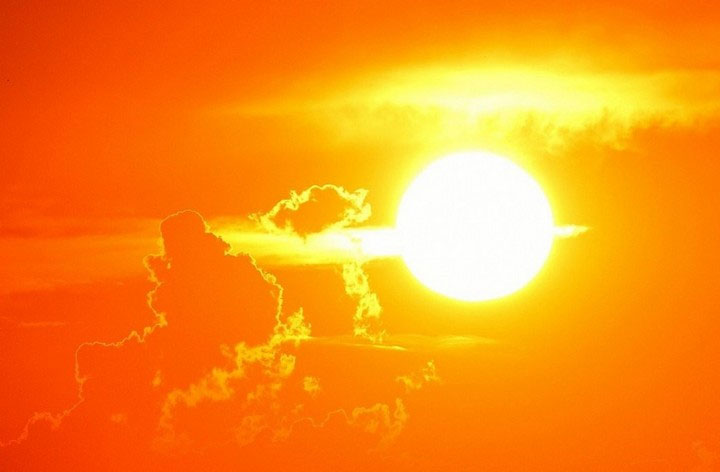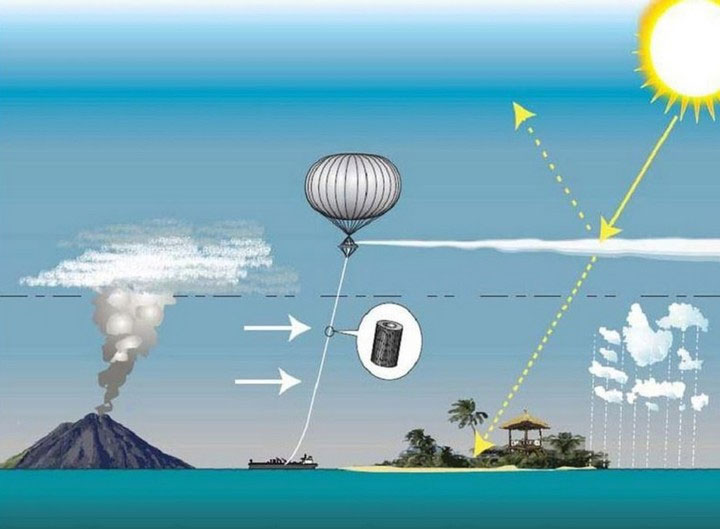Bill Gates supported $ 3 million for the project ... to shield the Sun from heat for the Earth
It seems that billionaire Bill Gates has never stopped thinking about great things and beyond human knowledge.
Blurring the Sun to save the Earth from warming? That's right, that's Bill Gates' goal when deciding to spend $ 3 million on a project to spray millions of tons of dust into the stratosphere to prevent global warming from Harvard University. However, researchers are also concerned that the project will cause another disaster.

This dust will create a giant shield, reflecting sunlight.
According to Dailymail , this sounding plan coming from science fiction can become true. According to calculations, if the project is carried out, scientists will have to mobilize 800 aircraft to carry millions of tons of chalk dust to an altitude of nearly 20km and then sprinkle it on the stratosphere.
In theory, this dust layer will create a giant shield, reflecting sunlight and radiating heat back into space, while blurring light shining on the Earth, preventing warming and turning. climate change.
Currently Harvard scientists are preparing to conduct the Controlled perturbation Experiment (SCoPEx) project in the sky. They will drop a hot air balloon and carry 2kg of calcium carbonate dust as a powder bag into the atmosphere at a height of nearly 20km in the New Mexico desert.
The ball will sow a layer of dust nearly 1 km long and has a radius of more than 76m 2 . In the next 24 hours, the balloon will be controlled to return to the dusty location and use the sensor to monitor the sun's reflectivity and its impact on the surrounding air. .

Description of the Controlled project perturbation Experiment (SCoPEx).
However, the SCoPEx project is temporarily delayed because of concerns that the project could create a series of chain reactions, destroying the climate and causing millions to die.
One of Harvard's directors, Lizzie Burns, admitted: "Our idea is basically crazy but climate change is equally fierce . " Now scientists have created an advisory council of independent experts to evaluate all related risks.
There are still many issues before this plan can come true
The idea of the project came from the volcanic eruption in 1991 . That year, the Pinatubo volcano in the Philippines erupted and killed more than 700 people and left 200 people homeless.
On this occasion, the scientists also monitored the impact of dust clouds covering the stratosphere. The volcano has emitted more than 20 million tons of sulfur dioxide into the atmosphere and produces droplets of sulfuric acid floating in the air for more than a year. These droplets are capable of reflecting sunlight. As a result, the global temperature measured that year decreased by 0.5 degrees Celsius.

The idea of the project came from the volcanic eruption in 1991.
Thanks to this unexpected result, scientists have come up with the idea of creating a layer of dust cloud to prevent sunlight and save the Earth.
But as mentioned, research is only in the early stages and there are many concerns that people need to address before taking into account large-scale implementation . The first is the cost of spraying dust clouds and the second is the management of climate risks.
Dust when dispersed into the stratosphere can disrupt the ozone layer that protects people from dangerous ultraviolet rays. In addition, scientists also fear dust will disrupt the circulation of the flow of harmonic.
More dangerous is that dust will indirectly change the way climate works, creating extreme weather events, devastating agricultural land, wiping out species and causing disease.
Furthermore, any change to global average temperature will lead to challenges in distributing heat globally. For example, some places are cooler and some are hotter. It also indirectly affects the rain pattern in the world. Many climate experts say that applying technology to combat climate change is good, but if it does not control all risks, it will become a disaster.
The cost of spraying is one thing, but the cost to maintain that cloud layer over the years and how to turn off that global cooling system is certainly not easy and scientists will take years I can find a solution.
- The project funded by Bill Gates predicts that the next pandemic will kill 33 million people in 25 days
- Bill Gates announced the Big History Project: History of 13.7 billion years of the universe
- Why is Bill Gates called a
- 10 immortal sayings of billionaire Bill Gates
- Bill Gates: Efforts to develop HIV vaccines
- Bill Gates spent millions of dollars researching ... human feces
- Bill Gates warned about the risk of bioterrorism that killed 30 million people
- How did Bill Gates start - The founder of Microsoft
- Bill Gates spent $ 100 million on research against Alzheimer's disease
- Bill Gates sponsors 'crazy' science ideas.
- 10 interesting facts about Bill Gates
- Bill Gates spent $ 15 million on the computer museum
 Is the magnetic North Pole shift dangerous to humanity?
Is the magnetic North Pole shift dangerous to humanity? Washington legalizes the recycling of human bodies into fertilizer
Washington legalizes the recycling of human bodies into fertilizer Lightning stone - the mysterious guest
Lightning stone - the mysterious guest Stunned by the mysterious sunset, strange appearance
Stunned by the mysterious sunset, strange appearance